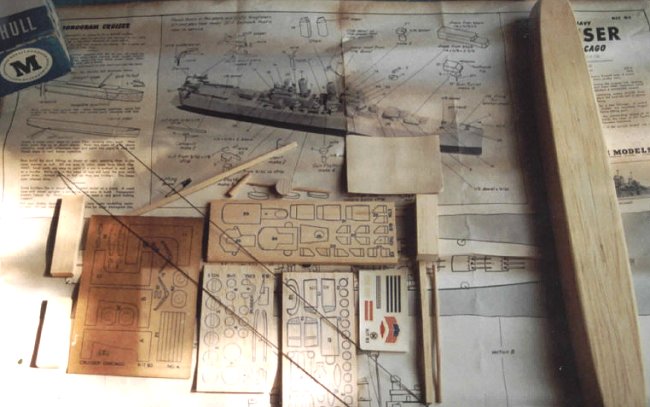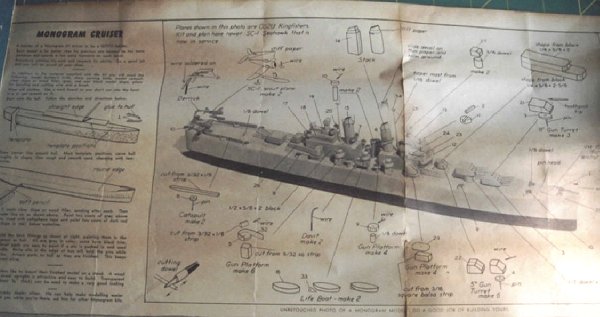
|
KIT: |
Monogram U.S.S. Chicago |
|
KIT # |
B3 |
|
PRICE: |
@$178,000 (came with house) retail $1.25 |
|
DECALS: |
once ship |
|
REVIEWER: |
Mike Horrell |
|
NOTES: |
50's multi-media kit |

|
HISTORY |
Normally this section contains historical information on the object or personage from which the kit was drawn. Number of engines, development history, and usage all serve to provide a context from which the reader may judge the relative importance of the prototype within its field. Was it influential? Did it change history ala Enola Gay or Titanic? Does it symbolize an era like an R-2 Gee Bee? Is it just “cool”?
Well, this time we’re taking a different approach. The history that needs to be told is that of this specific kit, an inadvertent time capsule into a world of modeling before the advent of plastic models; an era of balsa wood, glue pots, tooth picks, dowel rods and printed cut outs. Of kids that played with their models, and, perhaps, of parents that did not always approve……
In 1986, my wife and I purchased a 1924 house in what had originally been a working class, rail-commuting neighborhood now becoming gentrified. Plaster walls were disintegrating into sand, cotton insulated wiring needed replacement, heart pine floors needed to be redone, ancient and leaky hot water radiators had to go, etc. One of our first goals was to remove obviously amateur built and truly ugly bookcases that boxed in the area around the living room windows. Hammer and crowbar in hand, I pried off the large upper fascia revealing a hollow area between the top of the bookcase and the ceiling. Approximately 16 inches deep and ten inches high, this space was covered in a heavy layer of dust, mouse droppings and mummified bugs, but at the very back, pushed flat against the wall, was a model box.
The box was covered in decades of crud, but was intact. I brushed the worst off then opened the box not knowing what I would find inside. I was stunned to see that it actually was a complete and unstarted Monogram USS Chicago. The instructions were browning and starting to crack in the folds, but while stiff, could still be spread out. The balsa sheets were still intact; the wire to be used for to make cranes and antennae was tarnished, but still had some of its original gleam. It was a treasure.
How did this kit become an accidental time capsule? We’ll probably never know, but there seems to be only two possibilities, one far more likely than the other.
One: someone hid a Christmas or birthday present for a young boy then forgot it. Unlikely at best.
Or Two: a kid really wanted this model, wanted it badly enough to purchase it against his parents’ wishes. Smuggled in, it’s in desperate need of a hiding place. The open area atop the newly built bookshelves is perfect because you can’ t see the rear without standing on a chair. In it goes. Then, disaster! The father comes in from the porch carrying a freshly cut piece of 1 X 16, shoves it into place flush against the opening and drives in a couple of set nails before nailing it securely.
Nothing can be done. It’s an earlier America where Truman is president, the Red Menace is everywhere, war is see-sawing back and forth across the Korean peninsula, corporal punishment is the rule, not the exception, and the first thing expected from a child is not self-realization, but obedience. Bitter as it may be, accepting the loss of the kit is preferable to admitting defiance. True? I dunno, but not at all unlikely.
|
THE KIT |

Copyright in 1945, the kit is sturdily packaged in an unsealed 2x4x18 box with the original $1.25 sticker still attached on one end. The cover art appears to be taken from a pen and ink original and cannot be relied upon for accuracy. Large letters proclaim “WITH SHAPED BALSA HULL”. The emphasis on this feature implies a lot about the state of modeling when the kit was designed. One can readily imagine that a Bowie knife was the primary modeling tool of that era much as the airbrush is today. Scary.
Within are found the materials from which to form the kit:
·
Balsa
blocks from which to carve the superstructure
·
Four
toothpicks to be used to form gun barrels
·
Thick balsa sheets with
the preprinted images of gun tubs, turrets, cranes and rudders that are to be
cut and sanded to shape.
·
Two 12 inch, .008 steel
rods from which davits and other fixtures can be cut and bent to shape
·
A 16” long, partially
shaped balsa hull that will need final contouring using the templates provided
·
Several lengths of oak
dowel from which to shape director towers
·
A single, small sheet
consisting of a waving American flag, hull numbers, bridge windows and 10
Japanese flag “kill” markings
·
A single sheet set of
instructions measuring 24x16 providing both profile and elevated views that are
the exact length of the
completed model and used to illustrate component placement in the absence of
pins and tabs
·
One 2”x2” sheet of course
sandpaper to be used in final shaping and trimming of parts.

The instructions note that 2 coats of clear dope or wood filler is to be applied to the hull, then the model is to be finished with “2 coats of gray above waterline” and “dark red (black in red dope) below waterline”.
The modeler is cautioned to “Attach parts to the hull as they are finished. This keeps your interest alive.”
There is no room here for abstract arguments of “assemblers” vs. “modelers”. There are no rivets to count and no scale is provided to judge accuracy by. If it’s ever going to be completed, a fair amount of shaping and scratch building will be required. Quoted directly from the instructions:
“A builder of a Monogram kit strives to be a GOOD builder. Each model is far better than his previous one because he has more patience and spends a few extra moments on each detail.
Everybody admires his work and respects his ability. Do a good job and you will be proud of your ships.”
The kit may be obsolete, the advice is not.
|
REFERENCES |
Just my own amazement and sense of
wonder at having stumbled onto this nostalgic treasure. To me, it’s almost worth
more than the building it came with.
If you would like your product reviewed fairly and quickly by a site that has well over 150,000 visitors a month, please contact me or see other details in the Note to Contributors.